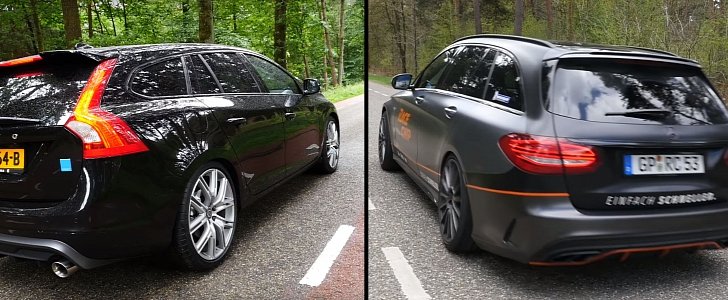Volvo is currently betting big on four-cylinder engines as it doesn't have any units with a larger displacement than two liters across its range. Sure, the top gasoline ones are helped by a hybrid system, but that's only to reach over 400 horsepower.
After receiving a little attention from Polestar, formerly Volvo's performance division and now a stand-alone company that's just released its first model, the two-liter turbocharged unit can go as high as 367 horsepower, as well as 470 Nm (346 lb-ft). That should be more than enough to move an SUV, not to mention a compact-sized station wagon.
However, the aging Swede is up against a Mercedes-AMG C-Class. It's not Affalterbach's finest in this range, the C 63 S with its 510 hp and fire-spitting V8 engine. It's not even the more toned down non-S version, which still packs 476 hp. No, it's the entry-level C 43 which just happens to have the exact same power output as the Volvo.
Similarities end there, though, as the powertrains of the two super family cars have very little in common beyond that. For one thing, the Volvo has two-thirds the number of cylinders and two-thirds the displacement. That's right, the baby AMG C-Class gest a three-liter turbocharged V6 engine, which means it's bound to have better torque (520 Nm/383 lb-ft) but also a greater mass.
Well, you'd be wrong about the latter, as the Mercedes-AMG is a bit lighter, which makes it 0-62 mph time of only five seconds a little baffling. Especially since the Volvo is allegedly quicker at 4.8 seconds. Official data suggests both cars should have an identical acceleleration time.
These side-by-side comparisons may not be bulletproof, but they do provide us with some perspective on where the two cars stand relative to each other. As you would expect, the Mercedes-AMG is quicker to both 100 km/h (62 mph) and 250 km/h (155 mph), but not by much. And considering the Volvo V60 Polestar is a rather old car, the result is all the more impressive.
In fact, the only thing letting the Swedish performance wagon down is its design, which is definitely showing its age. A lot of people (myself included) won't like the slightly exaggerated AMG either with its checkered flag dials and very loose use of colors, but we doubt these would weigh strongly enough to tilt the balance in Volvo's favor.
However, the aging Swede is up against a Mercedes-AMG C-Class. It's not Affalterbach's finest in this range, the C 63 S with its 510 hp and fire-spitting V8 engine. It's not even the more toned down non-S version, which still packs 476 hp. No, it's the entry-level C 43 which just happens to have the exact same power output as the Volvo.
Similarities end there, though, as the powertrains of the two super family cars have very little in common beyond that. For one thing, the Volvo has two-thirds the number of cylinders and two-thirds the displacement. That's right, the baby AMG C-Class gest a three-liter turbocharged V6 engine, which means it's bound to have better torque (520 Nm/383 lb-ft) but also a greater mass.
Well, you'd be wrong about the latter, as the Mercedes-AMG is a bit lighter, which makes it 0-62 mph time of only five seconds a little baffling. Especially since the Volvo is allegedly quicker at 4.8 seconds. Official data suggests both cars should have an identical acceleleration time.
These side-by-side comparisons may not be bulletproof, but they do provide us with some perspective on where the two cars stand relative to each other. As you would expect, the Mercedes-AMG is quicker to both 100 km/h (62 mph) and 250 km/h (155 mph), but not by much. And considering the Volvo V60 Polestar is a rather old car, the result is all the more impressive.
In fact, the only thing letting the Swedish performance wagon down is its design, which is definitely showing its age. A lot of people (myself included) won't like the slightly exaggerated AMG either with its checkered flag dials and very loose use of colors, but we doubt these would weigh strongly enough to tilt the balance in Volvo's favor.









